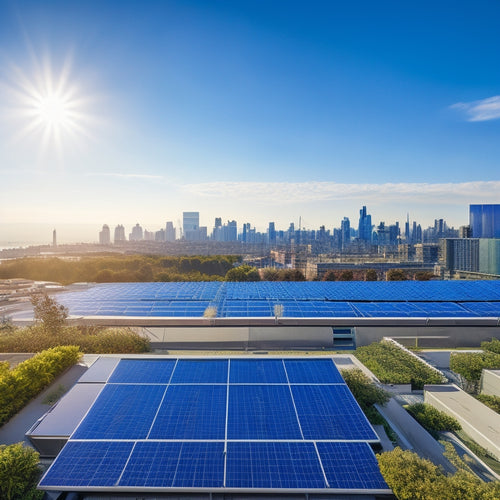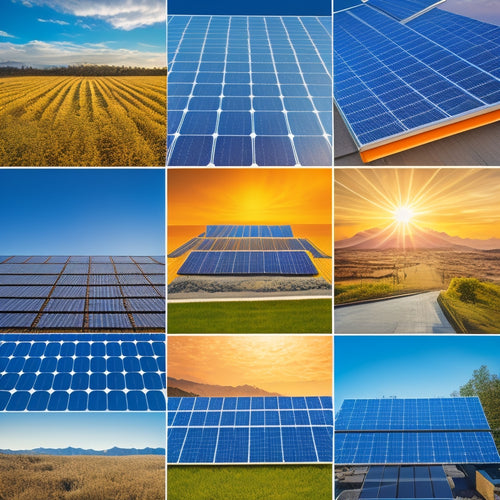
What Does a Commercial Solar Panel System Picture Look Like?
Share
You're likely picturing a commercial solar panel system as a sprawling array of photovoltaic modules installed on a rooftop or in an open field, generating clean energy and reducing your business's carbon footprint. The system typically consists of solar panels, inverters, a mounting system, and a monitoring system. The panels are secured to the roof or ground using clamps, brackets, and rails, while the inverters convert DC electricity into AC electricity for compatibility with your infrastructure. Aesthetics and energy production efficiency are balanced through optimized layouts and module arrangements. As you investigate further, you'll uncover the intricate details that bring this clean energy solution to life.
Key Takeaways
- A commercial solar panel system typically consists of rows of panels installed on a roof or ground-mounted, with a clean and uniform layout.
- The system may include inverters, mounting systems, and tracking systems, which are often hidden from view to maintain aesthetics.
- The panels are usually mounted at an angle to maximize energy production, with a slight gap between rows to allow for airflow and maintenance.
- The system may feature a monitoring system with a dashboard to track energy production and consumption, providing real-time data to optimize performance.
- The overall appearance of a commercial solar panel system is sleek, modern, and professional, blending in with the surrounding architecture.
Defining Commercial Solar Panel Systems
When evaluating renewable energy options for your business, installing a commercial solar panel system can be a lucrative investment.
Commercial solar panel systems convert sunlight into electricity, providing a clean and sustainable source of power. There are several system types to examine, each designed to meet specific energy needs.
Grid-tied systems are the most common, allowing your business to draw energy from the grid when needed. Off-grid systems, on the other hand, are ideal for remote locations where traditional power infrastructure is lacking.
Hybrid systems combine both grid-tied and off-grid capabilities, offering maximum energy efficiency.
When assessing commercial solar panel systems, energy efficiency is a critical factor. Look for systems with high-efficiency panels, inverters, and mounting systems to maximize energy production.
A well-designed system can reduce your business's carbon footprint while generating significant savings on energy costs.
Typical System Components Overview
A commercial solar panel system typically comprises several key components, each playing a crucial role in utilizing and converting sunlight into electricity. As a business owner, you want to guarantee that your system is optimized for commercial energy efficiency, and that's where these components come in.
| Component | Description |
|---|---|
| Solar Panels | Convert sunlight into DC electricity, with consideration given to solar panel aesthetics to guarantee a visually appealing installation |
| Inverters | Convert DC electricity from solar panels into AC electricity, suitable for your business's electrical infrastructure |
| Mounting System | Secures solar panels to your roof or ground, guaranteeing a safe and reliable installation |
| Monitoring System | Tracks your system's performance, providing real-time data to optimize energy production and identify potential issues |
These components work together to provide a seamless and efficient energy solution for your business. By understanding each component's role, you can make informed decisions about your commercial solar panel system, guaranteeing it meets your energy needs and enhances your bottom line.
Array Configuration and Design
The array configuration and design of your commercial solar panel system are essential factors in maximizing energy production and ensuring a seamless integration with your business's electrical infrastructure.
You'll want to evaluate the array layout, factoring in the available roof space, obstructions, and shading patterns. A well-designed array layout can optimize energy production by minimizing losses and ensuring each panel is operating at its maximum potential.
Design aesthetics also play a significant role in the overall system design. You'll want to balance the need for maximum energy production with the visual appeal of the system.
This may involve using a uniform panel layout, selecting panel frames and colors that complement your building's design, or incorporating subtle design features that enhance the system's appearance.
Mounting and Racking Systems Used
When you're designing a commercial solar panel system, you'll need to take into account the mounting and racking systems that will securely hold your panels in place.
You'll have to choose from clamps and holders, roof-mounted racking systems, and tracking systems that optimize energy production.
Each option has its own set of benefits and drawbacks, and understanding their differences is essential to ensuring a successful installation.
Clamps and Holders
Twenty to thirty clamps and holders are typically used in a standard commercial solar panel system, securing the photovoltaic modules to the mounting structure.
These clamps and holders are essential components, as they guarantee the solar panels are safely and securely fastened, allowing them to operate at peak efficiency.
You'll typically find two types of clamps: mid-clamps and end-clamps. Mid-clamps secure the modules to the racking system, while end-clamps fasten the modules to the outer frame.
Holder materials vary, but aluminum and stainless steel are common due to their durability and resistance to corrosion.
When selecting clamps and holders, consider the specific requirements of your commercial solar panel system.
Factors such as wind loads, snow loads, and module thickness influence the type and number of clamps needed.
Additionally, verify the clamps and holders are compatible with the mounting structure and photovoltaic modules.
Proper installation of clamps and holders is essential to prevent damage to the system and guarantee peak energy production.
Roof-Mounted Racking
In commercial solar panel systems, roof-mounted racking serves as the backbone, providing a solid foundation for the photovoltaic modules. As you examine the system, you'll notice that roof-mounted racking is designed to securely fasten the solar panels to your roof. This racking system consists of clamps, brackets, and rails that are carefully engineered to guarantee the structural integrity of your roof while supporting the weight of the solar panels.
When selecting a roof-mounted racking system, you should consider the solar panel aesthetics and how they'll integrate with your building's design. A well-designed racking system won't only enhance the appearance of your solar panel system but also assure roof durability.
Look for racking systems that are made from high-quality materials, such as anodized aluminum or stainless steel, which can withstand harsh weather conditions.
Additionally, consider the type of roof you have, as different racking systems are designed for specific roof types, such as flat roofs, pitched roofs, or metal roofs. By choosing the right roof-mounted racking system, you can guarantee a safe, efficient, and durable solar panel installation that meets your energy needs.
Tracking Systems Used
Frequently, commercial solar panel systems employ tracking systems that optimize energy production by adjusting the angle and orientation of the photovoltaic modules to capture the maximum amount of sunlight.
These solar tracking systems allow you to maximize your energy output by up to 45% compared to fixed-tilt systems. You'll find that tracking systems are typically used in large-scale commercial solar installations, where every increment of energy production matters.
There are two primary types of tracking systems: single-axis and dual-axis. Single-axis trackers adjust the angle of the panels to follow the sun's daily movement, while dual-axis trackers also adjust for the sun's seasonal changes.
Both types of tracking systems can be designed to accommodate different terrain and environmental conditions. By using tracking systems, you can achieve efficiency optimization and increase your return on investment.
With advanced technology and precise engineering, tracking systems guarantee that your commercial solar panel system operates at peak performance, generating more power and revenue for your business.
Inverters and Electrical Infrastructure
Your commercial solar panel system relies on an essential component to convert DC power into usable AC electricity: the inverter. This vital device guarantees that the energy generated by your solar panels is compatible with your building's electrical infrastructure.
You'll need to choose from several inverter types, including central, string, and microinverters, each with its own advantages and disadvantages. Central inverters are often used in large-scale systems, while string inverters are more suitable for smaller installations. Microinverters, on the other hand, are ideal for systems with multiple solar panels.
Electrical safety is a top priority when designing your commercial solar panel system. Your inverter and electrical infrastructure must meet local building codes and regulations to secure safe and efficient energy production.
A well-designed system will include features such as ground fault protection, arc fault detection, and surge protection to prevent electrical shocks and fires. By selecting the right inverter and electrical infrastructure, you'll be able to utilize the full potential of your solar panel system while guaranteeing the safety of your building and its occupants.
Monitoring and Tracking Performance
Commercial solar panel systems generate a vast amount of data, and utilizing this information is crucial to optimize their performance. You need to monitor and track your system's performance to guarantee it's operating at its best. This is where a monitoring system comes in.
A good monitoring system will provide you with real-time data on your system's performance metrics, such as energy production, consumption, and efficiency. You'll be able to see how much energy your system is producing, how much you're consuming, and where you can improve.
Data visualization is key to making sense of this data. A user-friendly dashboard will display your system's performance metrics in a clear and concise manner, allowing you to quickly identify trends and patterns.
This information will enable you to make informed decisions about your energy usage and optimize your system's performance. With real-time monitoring and data visualization, you'll be able to identify potential issues before they become major problems, guaranteeing your system runs smoothly and efficiently.
Installation and Maintenance Needs
A well-designed commercial solar panel system requires careful planning and execution during the installation process to guarantee peak performance.
When you're considering a commercial solar panel system, it's important to understand the installation and maintenance needs to secure optimal energy production.
During installation, you'll face challenges such as:
- Roof size and structure: Making sure your roof is large enough and structurally sound to support the solar panels.
- Electrical infrastructure: Upgrading your electrical infrastructure to accommodate the increased power output.
- Local building codes: Complying with local building codes and regulations.
Regular maintenance is vital to maintain peak performance and extend the system's lifespan.
You'll need to establish maintenance schedules for tasks such as cleaning the solar panels, inspecting electrical connections, and monitoring system performance.
Visualizing Energy Savings Potential
Energy cost savings projections help businesses grasp the financial benefits of investing in a solar panel system. By analyzing your energy usage and costs, you can envision the potential savings of switching to solar power. This cost analysis provides a clear depiction of your energy efficiency and the environmental impact of your operations.
With solar power, you can expect a significant return on investment, as well as reduced energy costs and increased grid independence.
You'll want to contemplate technology advancements, financing options, and installation timelines when planning your solar panel system. Policy incentives, such as tax credits and rebates, can also impact your decision.
Looking ahead, future trends in solar energy suggest continued growth and adoption, making now a prime time to invest.
Frequently Asked Questions
Can I Install a Commercial Solar Panel System on a Flat Roof?
You can install a commercial solar panel system on a flat roof, but you'll need to contemplate specific installation requirements, such as ensuring the roof's structural integrity, waterproofing, and ballasting the system to meet flat roof considerations.
How Long Does the Installation Process Typically Take?
You'll typically spend 2-6 months on the installation process, depending on the installation timeline, which is influenced by factors like system size, roof complexity, and local permits, ensuring a smooth shift to renewable energy.
Are Commercial Solar Panels Eligible for Government Incentives?
As you shine a light on commercial solar panels, you'll unearth a wealth of government incentives, releasing commercial benefits like tax credits and grants, helping your business thrive under the radiant glow of renewable energy.
Do Commercial Solar Panels Require Regular Cleaning?
You'll need to clean your commercial solar panels regularly to maintain efficiency, as dirt accumulation reduces energy output; ideal cleaning frequency depends on environmental factors, but a general rule of thumb is to clean every 6-12 months.
Can I Upgrade My Existing System to a Larger Capacity?
You can upgrade your existing system to a larger capacity by evaluating your current system's compatibility and performing a capacity assessment to determine the feasibility of adding more panels or inverters, ensuring a seamless integration.
Conclusion
Now that you've got a sense of what a commercial solar panel system looks like, it's time to take action. With the average commercial property owner saving around $500 per month on their electricity bill, the benefits are clear. In fact, did you know that commercial solar installations can increase property value by up to 10%? That's a significant enhancement to your bottom line. By going solar, you can lock in low energy rates, reduce your carbon footprint, and reap the financial rewards.
Related Posts
-

Business Solar Investments for Cost-Effective Sustainability
Investing in solar energy is a smart move for your business, providing a solid foundation for cost-effective sustaina...
-

Energy-Efficient Heating and Cooling Appliances
Energy-efficient heating and cooling appliances can cut your energy bills markedly. By opting for models with high En...
-

Comparative Analysis of Top Solar Brands
To conduct a comparative analysis of top solar brands, focus on key metrics like durability, energy efficiency, and s...


